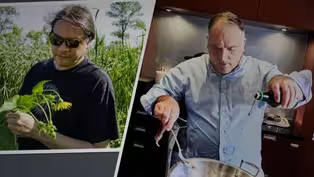Finding Your Roots
Sean Sherman Learns About A Tragic Past
Clip: Season 11 Episode 5 | 4m 7sVideo has Closed Captions
Sean learns of his ancestor who was sent to the Carlisle Indian Industrial School.
Sean learns his paternal great-great grandmother was sent east as a child to the Carlisle Indian Industrial School, a decision which forced her to abandon her culture and family.
Problems playing video? | Closed Captioning Feedback
Problems playing video? | Closed Captioning Feedback
Corporate support for Season 11 of FINDING YOUR ROOTS WITH HENRY LOUIS GATES, JR. is provided by Gilead Sciences, Inc., Ancestry® and Johnson & Johnson. Major support is provided by...
Finding Your Roots
Sean Sherman Learns About A Tragic Past
Clip: Season 11 Episode 5 | 4m 7sVideo has Closed Captions
Sean learns his paternal great-great grandmother was sent east as a child to the Carlisle Indian Industrial School, a decision which forced her to abandon her culture and family.
Problems playing video? | Closed Captioning Feedback
How to Watch Finding Your Roots
Finding Your Roots is available to stream on pbs.org and the free PBS App, available on iPhone, Apple TV, Android TV, Android smartphones, Amazon Fire TV, Amazon Fire Tablet, Roku, Samsung Smart TV, and Vizio.
Buy Now

Explore More Finding Your Roots
A new season of Finding Your Roots is premiering January 7th! Stream now past episodes and tune in to PBS on Tuesdays at 8/7 for all-new episodes as renowned scholar Dr. Henry Louis Gates, Jr. guides influential guests into their roots, uncovering deep secrets, hidden identities and lost ancestors.Providing Support for PBS.org
Learn Moreabout PBS online sponsorshipWe'd already seen how Sean Sherman's maternal ancestors met in Fort Laramie, Wyoming, as white Americans were violently encroaching on native lands in the west.
Now, turning to Sean's father's roots, we found ourselves revisiting that painful era.
The story begins in 1879 when Sean's great-great-grandmother, a young woman named Lizzie Glode, was taken from her family home in South Dakota and sent east to Pennsylvania to attend what was known as the Carlisle Indian Industrial School.
Carlisle was the first of many boarding schools designed to assimilate native children into white society.
And Sean knows a great deal about its dark history.
But we were able to personalize that history, starting with a letter written by the school's founder, describing how his first pupils had been selected.
"Through the efforts of the acting agent, agency employees, the missionaries and chiefs, five female and 10 male children were brought in.
The following is a list of the children brought to Carlisle from Rosebud and Pine Ridge Agencies.
English name, Daisy Glode, age 15.
Band, Oglala."
Have you ever seen that document?
I have not, no.
Sean, this is the moment that your great-great grandmother, Lizzie, recorded there as Daisy, was selected to go to the Carlisle School and she was just 15 years old.
Okay.
How does it feel seeing that?
I mean, I know of a lot of the atrocities that happened there 'cause I visited there and I've seen the graveyard of all of the young native children that lie there.
And actually, that graveyard is a third of the size that it used to be.
They moved all the graves because it was taking up too much space on their campus.
You know?
But there's just a lot of pain that happens in Carlisle, and that whole methodology of assimilation, of course, spreads like wildfire across the US and Canada.
Carlisle's founder was an army veteran named Richard Henry Pratt.
Pratt had fought against Native nations on the Great Plains.
And he founded his school with the financial support of the United States government, believing that indigenous peoples could only be integrated into white society if they gave up their traditional cultures.
With this goal in mind, Pratt traveled across the west trying to persuade tribal leaders to send him their own children without any regard to all that would be lost in the process.
"The fathers of these children are Chiefs or leading men in their tribes.
And while the training and development of their children into manly, self-supporting men and women goes forward, their parents, relatives and friends will be restrained by the fact and incited to seek for themselves a better state of civilization.
They have great affection for their children, thousands gathered at each agency to see them off and more affecting tears, grief and mourning could not be imagined.
Chiefs whose names are known all over the country exhibited all the emotions of the kindest natures."
So can you imagine?
So much pain, you know?
And I've seen pictures of the train cars filled with young, native children.
And I can only imagine the grief of the mothers and the grandmothers who had been raising everybody.
And I've always understood that this has been a part of the family, that this has lived with us.
And knowing what they're going to doesn't help.
I mean, you could tell that even though the chiefs ostensibly acquiesced to send some of their children to the school, this was a devastating separation.
Yeah, I mean, they were left with no choice because either they send the children or they get no food, supplies or anything that else, whatever's been promised to them.
'Cause they're basically prisoners of war at this point.
Video has Closed Captions
Preview: S11 Ep5 | 30s | Henry Louis Gates, Jr. explores the ancestry of notable chefs José Andrés & Sean Sherman. (30s)
José Andrés Discovers His Ancestors Were Bakers
Video has Closed Captions
Clip: S11 Ep5 | 4m 41s | José discovers his paternal great-great grandmother was abandoned and given to nuns as a baby. (4m 41s)
Providing Support for PBS.org
Learn Moreabout PBS online sponsorship
- History
Great Migrations: A People on The Move
Great Migrations explores how a series of Black migrations have shaped America.












Support for PBS provided by:









